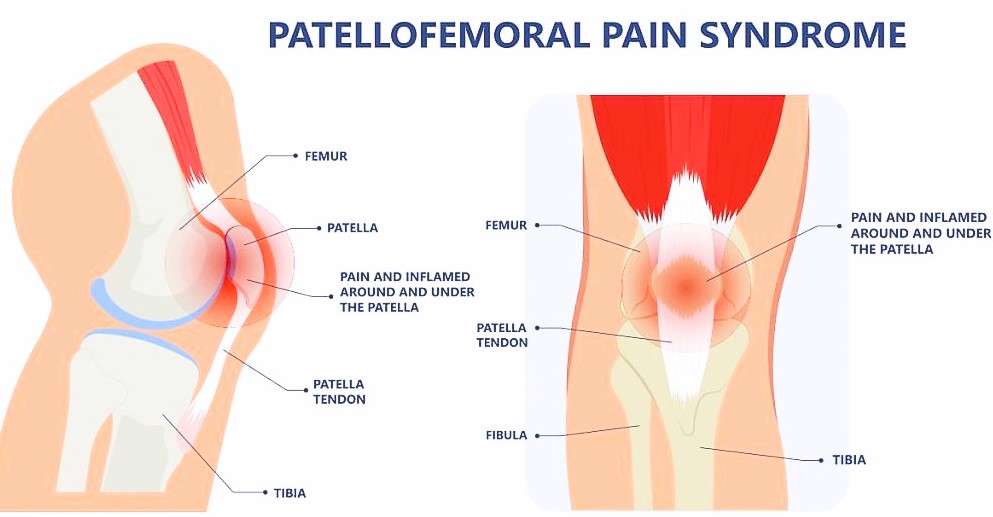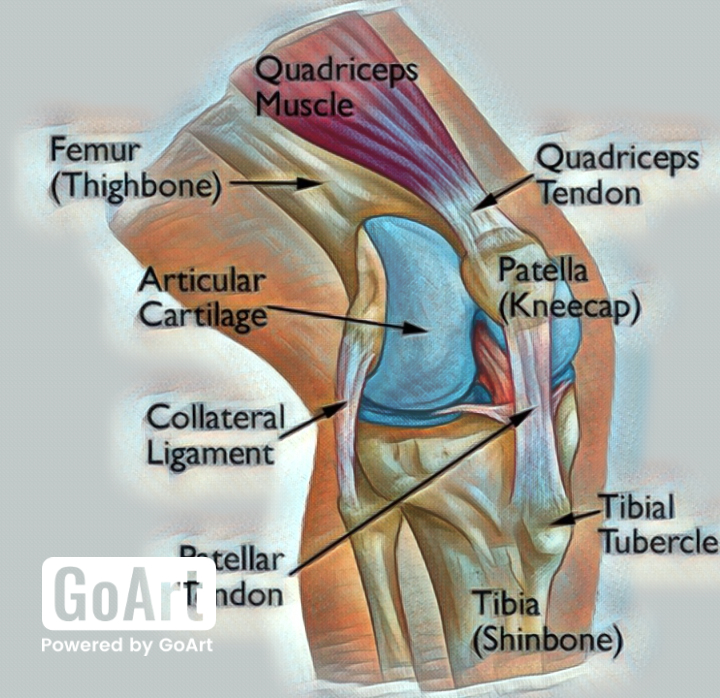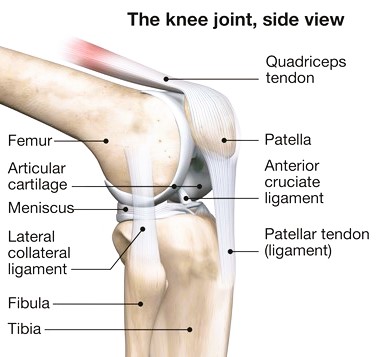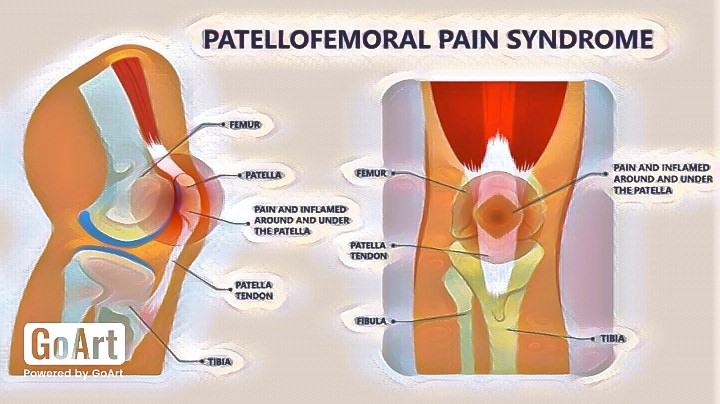Introduction:
Patellofemoral pain syndrome, also known as “runner’s knee,” is a common injury among athletes and active individuals. It occurs when the knee joint experiences excessive stress and pressure, leading to pain and discomfort in the front of the knee. This condition can be caused by a variety of factors, including overuse, improper training techniques, and muscle imbalances.
What is Patellofemoral Pain Syndrome?
This joint (patellofemoral pain syndrome is situated between knee cap and thigh bone (femur). This joint plays a crucial role in knee movement, as the patella acts as a pulley to help the quadriceps muscles extend the knee. When the patella is not tracking correctly in the femoral groove, the joint experiences increased stress and pressure, leading to pain and inflammation. Patellofemoral pain syndrome can be caused by a number of factors, including muscle imbalances, overuse, and improper training techniques.

Symptoms:
Symptoms of patellofemoral pain syndrome include pain and discomfort in the front of the knee, especially when the knee is bent or bearing weight. Other common symptoms include swelling and stiffness in the knee, as well as a popping or grinding sensation in the joint. Some people may also experience a feeling of instability in the knee, especially when walking or climbing stairs.
Some common symptoms of PFPS include:
- Pain or discomfort in the front of the knee, particularly around or under the patella
- Stiffness and weakness in the knee joint
- A popping or grinding sensation in the knee joint
- Swelling or inflammation in the knee joint
- Difficulty fully extending the knee
- A feeling of the knee giving out or buckling
- Pain or discomfort when going up or down stairs, squatting, or sitting for long periods of time
The pain associated with PFPS may be described as a dull ache or sharp, intense pain. The pain may be worse when going up or down stairs, or when sitting with the knee bent for long periods of time. It may also be worse after activity or exercise. Many people with PFPS also report a popping or grinding sensation in the knee joint.
Physical examination may show signs of muscle weakness, particularly in the quadriceps muscles that control the knee cap, as well as muscle imbalances and asymmetries.
Imaging tests, such as X-rays or MRI, are often not necessary for a diagnosis of PFPS, as the condition can usually be diagnosed based on a person’s symptoms and physical examination. However, imaging tests may be used to rule out other knee conditions or injuries that could be causing the symptoms.

Causes:
Patellofemoral pain syndrome is caused by a variety of factors. Overuse is one of the most common causes, particularly among athletes who participate in sports that involve repetitive knee movements, such as running, cycling, and jumping. Improper training techniques, such as suddenly increasing the intensity or duration of your workout, can also lead to patellofemoral pain syndrome.
Muscle imbalances can also contribute to the development of patellofemoral pain syndrome. The quadriceps muscles on the front of the thigh are responsible for extending the knee, while the hamstrings and calf muscles on the back of the thigh and lower leg help to flex the knee. When these muscles are not in balance, the quadriceps can overpower the other muscles, leading to improper tracking of the patella.
Prevention:
Preventing patellofemoral pain syndrome can be accomplished by following a few simple steps. First, make sure to properly warm up and cool down before and after exercising. This can help to reduce the risk of injury and improve the flexibility of the muscles surrounding the knee.
Second, pay attention to your training schedule. Gradually increase the intensity and duration of your workout to avoid overuse. It is also important to address any muscle imbalances you may have by incorporating exercises to strengthen the muscles around the knee.
Treatment:
The treatment for patellofemoral pain syndrome typically includes a combination of rest, ice, and physical therapy. Rest and ice can help to reduce pain and inflammation in the joint, while physical therapy can help to improve the strength and flexibility of the muscles surrounding the knee.
Physical therapy exercises for patellofemoral pain syndrome typically focus on improving the strength and flexibility of the quadriceps, hamstrings, and calf muscles. This can be accomplished through a variety of exercises, such as squats, lunges, and leg presses. Your physical therapist may also teach you exercises to improve the alignment and tracking of the patella, such as kneecap mobilization exercises.
In addition to physical therapy, your doctor may also prescribe medications to help manage pain and inflammation.
In some cases, a knee brace or orthotic may be recommended to help support the joint and improve patella tracking. Surgery may be required in some of the complicated cases. Surgery may involve realigning the patella or addressing any underlying issues with the knee joint.

Physiotherapy Management:
Physical therapy is an essential component of the management of patellofemoral pain syndrome. The goal of physiotherapy is to reduce pain, improve function, and prevent recurrence of the condition.
A physiotherapist will work with you to develop an individualized treatment plan that addresses your specific needs and goals. This may include a combination of exercises to improve strength, flexibility, and alignment of the knee.
Exercises that target the quadriceps, hamstrings, and calf muscles are typically recommended to improve muscle balance and support the knee joint. Strengthening exercises may include squats, lunges, leg presses, and leg extensions. Stretching exercises are also important to maintain flexibility and prevent muscle imbalances.
Your physiotherapist may also teach you exercises to improve the alignment and tracking of the patella, such as kneecap mobilization exercises. These exercises can help to reduce pain and improve the function of the knee joint.
In addition to exercises, your physiotherapist may also use other techniques to help manage your pain and improve your function. These may include joint mobilization, soft tissue massage, and ultrasound therapy.
Your physiotherapist will also work with you to develop a home exercise program to continue your progress and prevent recurrence of the condition. It is important to continue with your home exercise program even after your symptoms have resolved to maintain the strength and flexibility of the muscles around the knee.

In summary, Patellofemoral pain syndrome is a common injury among athletes and active individuals that can cause pain and discomfort in the front of the knee. It is important to address any muscle imbalances, overuse, and improper training techniques to prevent the condition. Physical therapy is an essential component of the management of patellofemoral pain syndrome, which includes a combination of exercises to improve strength, flexibility, and alignment of the knee, in addition to other techniques to help manage pain and improve function.
